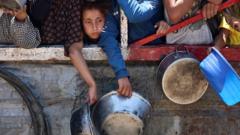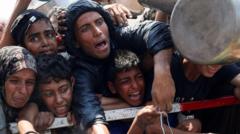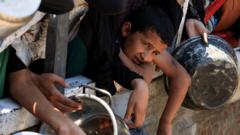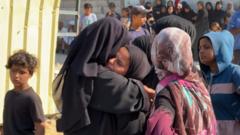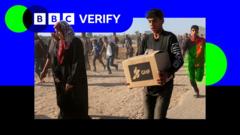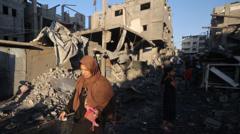**As Israel pauses military operations in Gaza, aid from Jordan and the UAE arrives, but violence persists, raising concerns over lasting humanitarian impacts.**
**Aid Efforts Intensify as Israel Implements Temporary Ceasefire in Gaza**
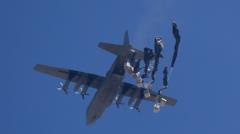
**Aid Efforts Intensify as Israel Implements Temporary Ceasefire in Gaza**
**Jordan and UAE airlift humanitarian supplies amid escalating crisis, while casualties continue.**
Jordan and the United Arab Emirates have launched humanitarian aid operations in Gaza, coinciding with a temporary pause in Israeli military actions. This initiative comes as the beleaguered region faces an acute humanitarian crisis exacerbated by ongoing conflict. On Sunday, Jordanian military aircraft collaborating with Emirati forces successfully delivered 25 tonnes of essential supplies through three air drops. Simultaneously, ground aid also made its way into Gaza from Egypt, with another lorry convoy anticipated from Jordan.
Announcing the pause, Israel stated it would suspend military activities for 10 hours each day in certain parts of Gaza, intending to ease humanitarian access and counter accusations of exacerbating starvation conditions. Despite this, reports from medical personnel indicated nine fatalities and over 50 injuries due to Israeli fire in close proximity to aid convoy routes in central Gaza. Notably, a residential airstrike occurred merely an hour after the ceasefire began, raising further alarm over ongoing civilian casualties.
Local sources confirmed that civilians had gathered along the Netzarim Corridor for incoming UN aid displays, only to be met with violence as warning shots were fired by Israeli troops aimed at what they termed a "suspected gathering."
The urgency for aid is palpable, with the UN's World Food Programme highlighting that one-third of Gaza's population is unable to secure food on a daily basis, leading to catastrophic conditions for many. Amid reports of malnutrition-related fatalities exceeding 100, the situation remains dire, with hundreds facing gunfire while attempting to retrieve vital supplies at limited distribution points.
Global political figures have weighed in on the efforts, with the UK’s foreign secretary, David Lammy, calling for more comprehensive and sustainable measures than air drops. Lammy emphasized the necessity of clearly defined land routes for continuous humanitarian support.
The UN’s high commissioner for human rights, Volker Türk, echoed these sentiments, demanding heightened international pressure to bring an end to the war and mitigate the escalating humanitarian crisis. President Donald Trump also announced intentions to bolster aid, framing the situation as a collective international responsibility rather than solely a U.S. issue.
In the Gaza Strip, residents cautiously welcomed the temporary ceasefire, exhibiting mixed emotions of hope and fear concerning the persistence of starvation once the pause concludes. As desperation mounts, many families report a complete lack of fresh food for extended periods, relying on canned goods that are often expired.
While air drops and ground convoys are welcomed by the local populace, concerns remain regarding their efficacy and safety, especially as noted by journalist Imad Kudaya. He indicated that many aid packages were landing in areas with considerable risk due to continuous military oversight.
As Israeli Prime Minister Benjamin Netanyahu reaffirmed the country’s commitment to achieving its military objectives, he declared that suitable routes for safe aid delivery would henceforth be open — an assurance that is being met with skepticism among aid agencies and affected civilians alike.
Under these new frameworks, Israeli forces have pledged to maintain humanitarian corridors within Gaza, facilitating essential components such as food and medical supplies from 6 AM to 11 PM daily, marking a potentially significant step towards alleviating the suffering of millions in the region.
Announcing the pause, Israel stated it would suspend military activities for 10 hours each day in certain parts of Gaza, intending to ease humanitarian access and counter accusations of exacerbating starvation conditions. Despite this, reports from medical personnel indicated nine fatalities and over 50 injuries due to Israeli fire in close proximity to aid convoy routes in central Gaza. Notably, a residential airstrike occurred merely an hour after the ceasefire began, raising further alarm over ongoing civilian casualties.
Local sources confirmed that civilians had gathered along the Netzarim Corridor for incoming UN aid displays, only to be met with violence as warning shots were fired by Israeli troops aimed at what they termed a "suspected gathering."
The urgency for aid is palpable, with the UN's World Food Programme highlighting that one-third of Gaza's population is unable to secure food on a daily basis, leading to catastrophic conditions for many. Amid reports of malnutrition-related fatalities exceeding 100, the situation remains dire, with hundreds facing gunfire while attempting to retrieve vital supplies at limited distribution points.
Global political figures have weighed in on the efforts, with the UK’s foreign secretary, David Lammy, calling for more comprehensive and sustainable measures than air drops. Lammy emphasized the necessity of clearly defined land routes for continuous humanitarian support.
The UN’s high commissioner for human rights, Volker Türk, echoed these sentiments, demanding heightened international pressure to bring an end to the war and mitigate the escalating humanitarian crisis. President Donald Trump also announced intentions to bolster aid, framing the situation as a collective international responsibility rather than solely a U.S. issue.
In the Gaza Strip, residents cautiously welcomed the temporary ceasefire, exhibiting mixed emotions of hope and fear concerning the persistence of starvation once the pause concludes. As desperation mounts, many families report a complete lack of fresh food for extended periods, relying on canned goods that are often expired.
While air drops and ground convoys are welcomed by the local populace, concerns remain regarding their efficacy and safety, especially as noted by journalist Imad Kudaya. He indicated that many aid packages were landing in areas with considerable risk due to continuous military oversight.
As Israeli Prime Minister Benjamin Netanyahu reaffirmed the country’s commitment to achieving its military objectives, he declared that suitable routes for safe aid delivery would henceforth be open — an assurance that is being met with skepticism among aid agencies and affected civilians alike.
Under these new frameworks, Israeli forces have pledged to maintain humanitarian corridors within Gaza, facilitating essential components such as food and medical supplies from 6 AM to 11 PM daily, marking a potentially significant step towards alleviating the suffering of millions in the region.



